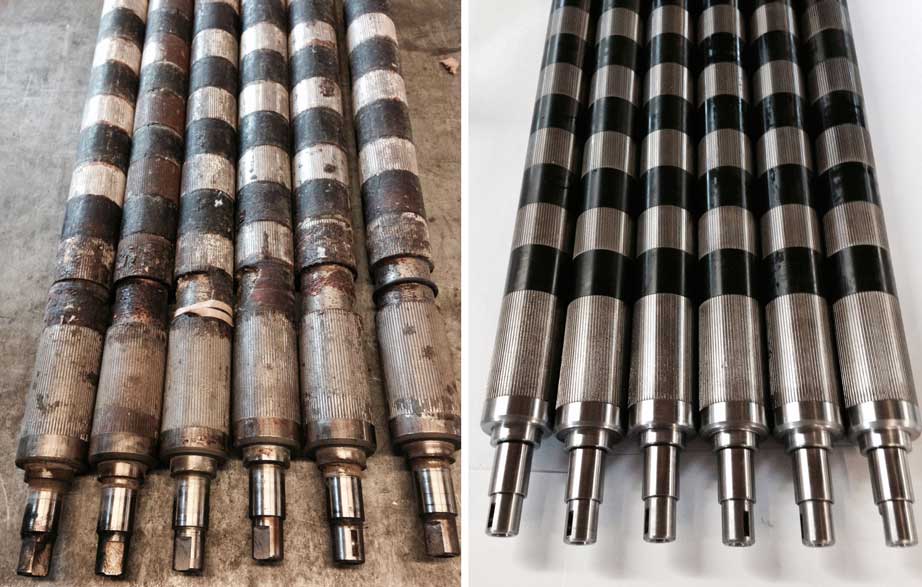NEVER REGRIND FOLDER ROLLERS
REGRINDING — A SHORT TERM GAIN AND A LONG TERM LOSS
We’ve been asked hundreds of times over the years if we “regrind” rollers. The answer is no. Suppliers who offer a regrinding service might be able to save you $20-30 at most over recovery prices. But this is a short term gain and a longer-term loss. Recovery, in which the urethane is completely replaced, adds the maximum life to your rollers, saving you replacement money, and is always a better alternative to regrinding. Here’s why.
When rollers are reground, a portion of the total diameter of the roller is removed, including both metal and urethane. The roller is ground to the point where the top of the knurl teeth across the roller been touched. The rollers may look good, but they will be on the low side of the OEM diameter specs or below. At the middle of the roller, the knurl tips will have been barely touched by the grinding operation, while at the ends of the roller the knurls have been erased.
Regrinding may get you back up and running again on the cheap, but not at OEM specs, and not at fast speeds that can be maintained. We will explain further.

Recovering and reknurling your rollers adds life to your valuable folder rollers.
The reason you need to recondition your rollers is because there is minimal grip of the paper. Loss of grip is caused by two things: first, roller urethane is worn down in the center of the roller and won’t grip the paper evenly from end to end; and second, the urethane has lost its “come-back” quality (it doesn’t come back after being pressed) and has become hardened, deteriorated, cracked, or even missing. The hard shell or glaze on the urethane is caused by age and abrasion. In most of the rollers we see, the urethane is well below the diameter of the steel knurls (teeth on the steel).
REGRINDING RESULTS IN UNDERSIZED, UNMATCHED ROLLER DIAMETERS
Bindery suppliers who regrind rollers with hardened urethane try to figure out how much more urethane can be removed from the roller while still allowing it to run paper, without regard to specs. Urethane is removed to eliminate high and low spots, as well as to remove the outer glaze and rejuvenate the urethane. With the outer glaze being as much as .010″ deep, regrinding will remove at least .015″ urethane to create “fresh” grip.
As you can imagine, this process causes the rollers to become undersized, as much as .010 to .012″ less per side than the original diameter when the roller was new. But with most used rollers that have lost their grip, the knurls have also rolled over. So, the roller re-grinder will remove more steel from the knurl teeth to make sure the rollers look good. A roller with re-ground knurls may be as much as .015 to .020″ undersized relative to its original (new) size and at best .010″ less than the other rollers in the set.
In addition to grinding your rollers to less than OEM diameter, regrinding fails to take into account the differing amount of wear among the roller set. When you are ready to replace or recondition your rollers, take them out and lay all six or eight next to each other on a flat surface. You’ll notice that three or four of the rollers are more worn than the others. When this discrepancy in wear is ignored in the regrinding process, high spots are ground down to match the low ones. The result is a set of rollers with different size diameters. When these differently-sized rollers are re-installed, you are likely to experience “gathering” when running. It’s like trying to run tires of different sizes on one car, and results in reduced running speeds.
A discrepancy of .010″ between roller diameters among the set may not sound like much, but it amounts to a .03″ difference in paper mis-feeding per revolution, or a real gathering problem resulting in lower run speeds.
The grinding of knurl steel also results in the eventual erasing of the teeth and loss of traction for driving the paper. In many cases there will be only a slight trace of knurl teeth in the center of the roller and the ends of the roller will show only smooth steel.
Let’s summarize the situation.
- You’ve had your rollers reground and re-installed. They look good.
- But the rollers were ground to different sizes (the better rollers weren’t ground as much as others) and this has caused a gathering problem.
- Some rollers were ground to the point where the knurl is practically gone.
- The ends of the rollers were ground more than in the middle.
- The glaze and hardness has been removed but the urethane diameter is less than it should be, the urethane has not been rejuvenated, and grip is not what it should be among all the rollers.
- Your rollers seemed to run faster at first, but before long they are actually running slower and slower, due to the lost traction of ground knurls. Before long, its time to get brand new rollers.
Regrinding has shortened the life of your rollers. Your sales rep knew that you would soon need new rollers and will be happy to sell them to you at 10-15% less than the OEM’s prices. If for some reason you are still thinking of re-grinding your rollers to save money, ask your bindery supplier how long he will warranty the reground rollers. Ask us about our services.
FolderRollers.com/Wear Ever Manufacturing provides a one-year warranty on all recovered rollers.